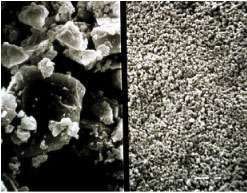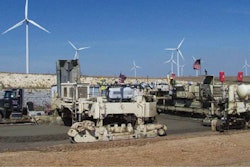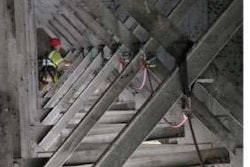A Concrete Solution:

By Tom Kuennen, Contributing Editor
Portland cement concrete (PCC) is the most widely used structural material in transportation infrastructure, and it’s widely used for pavements as well. But the control of freshly mixed PCC properties is essential to ensure workability during placement, and compressive strength and long-term durability.
Not unlike modifiers in bituminous pavements (see Asphalt a la Carte: Modifiers Control Mix Performance, April 2012, pgs. 16-27), mineral and chemical concrete admixtures work both physically and chemically to improve the durability and quality of portland cement concrete, boost or retard set time, increase resistance to frost, sulfate attack and alkali-silica reactivity, and improve placement.

Adding chemical admixtures to PCC before or during mixing can manage its rate of early hydration, and regulate its fluid (rheological) properties. The most common chemical admixtures include air-entraining agents, water reducers, superplasticizers (high range water reducers), retarders, and accelerators. Concrete admixtures are classified as either mineral or chemical.
Cement and Concrete
Hydraulic portland cement is the product of the calcining, or pyroprocessing, of limestone (a calcium compound), aluminosilicates (clays and/or sand), and iron oxide at phenomenal temperatures, in the range of 2,700 and 3,000 deg. F. The raw materials are crushed, screened and deposited in an inclined, refractory tile-lined cement kiln, which rotates while the materials undergo calcination.

During calcining, the raw materials tumble in the rotary kiln, moving downward as they are exposed to heat. The chemically combined water and carbon dioxide from the raw materials is driven off, leaving behind new compounds such as tricalcium silicate, dicalcium silicate, tricalcium aluminate and tetracalcium aluminoferrite, according to the Portland Cement Association.
These compounds are contained in the resulting fused lumps – the size of a fist or smaller – called clinker. This clinker tumbles out the lower end, is cooled and is either shipped (exported) elsewhere for grinding into cement, or ground at the plant in a ball mill, which results in an hydraulic portland cement that is so fine it will pass through a sieve that will hold water.
Fresh concrete, of course, is the mix of aggregates (sand and gravel or crushed stone), water and portland cement. Cement makes up from 10 to 15 percent of the concrete mix, by volume, although in recent decades the cement industry has encouraged specification of equally performing cement containing up to 15 percent limestone fines.
The addition of water initiates hydration of the cement, which binds the sand and aggregates into a hardened product resembling stone. Compounds like calcium hydroxide and calcium silicate hydrate form within the paste. The strength of concrete is measured by its resistance to compressive forces after a month of curing (28-day compressive strength). But curing actually continues for decades, albeit at a much slower pace. Theoretically concrete never really stops curing.
How Concrete Cures
The curing or hardening of PCC is a physio-chemical process that begins at the molecular level. The scale at which this curing takes place is the realm of the atom and molecule, generally 10 times the diameter of a water molecule, one-billionth of a meter, called a nanometer.
Concrete is a porous material, ranging from air voids to nanometer-scale pores produced by the cement-water chemical reaction, say Ken P. Chong, National Science Foundation, and Edward J. Garboczi, National Institute of Standards and Technology, in their paper Smart and Designer Structural Material Systems (download at http://www.fire.nist.gov/bfrlpubs/build03/PDF/b03006.pdf).
“Since these nanoscale pores control the properties of the calcium-silicate-hydrate hydration product, which is the main ‘glue’ that holds concrete together,” they say, “concrete is in some ways a nanoscale material.”
The new field of nanotechnology is giving us a better view of what is happening at the physio-chemical level as cement hydrates and concrete cures. Nuclear resonance reaction analysis (NRRA) is being used to study cement hydration at a nanoscale level. The result is a better idea of what takes place on the surface of the cement particle as it hydrates, leading to improved industry standards and guidelines for mixing and curing concrete.
NRRA uses a beam of nitrogen atoms to probe a reacting cement grain to locate hydrogen atoms, a necessary component of water, or its reaction products. The results of the probe are plotted in a graph called a hydrogen depth profile, which shows the rate of penetration of the water. This also indicates the arrangement of the various surface layers formed during the reaction.
The 20-nanometer-thick surface layer acts as a semi-permeable barrier that allows water to enter the cement grain and calcium ions to leach out. However, the larger silicate ions in the cement are trapped behind this layer.
As the reaction continues, a silicate gel layer forms beneath the surface layer, causing swelling within the cement grain and eventually leading to breakdown of the surface layer. This breakdown releases the accumulated silicate into the surrounding solution, where it reacts with calcium ions to form a calcium-silicate hydrate gel, which binds the cement grains together and sets the concrete.
The evolution of the hydrogen profile shows the time of breakdown of the surface layer. This information can be used to study the concrete setting process as a function of time, temperature, cement chemistry, and other factors. For example, researchers used NRRA to determine that in cement hydrating at 30 deg C (86 deg. F), the breakdown occurs at 1.5 hours.
Mineral Admixtures: Fly Ash
Mineral admixtures like fly ash, silica fume or microsilica, and slags are usually added to concrete to enhance the workability of fresh concrete; to improve resistance of concrete to thermal cracking, alkali-aggregate expansion, and sulfate attack; and to enable a reduction in cement content or water.
An industrial byproduct, fly ash is the residuum of the combustion of coal for electricity generation; its minute particles are finer than those of cement and are glassy-spherical in shape.
Fly ash is a pozzolan, meaning it is a siliceous and aluminous material that, in the presence of water, will combine with an activator (lime, portland cement or kiln dust) to produce a cementitious material, according to Fly Ash Facts for Highway Engineers, a publication of the FHWA, and authored by the American Coal Ash Association (ACAA).
The American Society for Testing and Materials (ASTM) classifies fly ash into Class C and Class F categories. Class C, with a higher calcium oxide content (CaO, or “lime”), comes from the burning of western sub-bituminous or lignite coals, and Class F is derived from bituminous eastern coals. Fly ash with high amounts of residual carbon is not suitable for use with concrete.
Research indicates that Class F fly ash is better suited for fighting alkali-silica reactivity (ASR), the common malady of concrete. As ASR’s presence is a function of deleterious aggregates, we will address it in our July installment, The Chemistry of Aggregates.
As it chemically reacts with cement, fly ash benefits concrete in these seven ways:
• Gains in concrete strength. Mix designs containing fly ash that produce equivalent strength at early ages – fewer than 90 days – will ultimately exceed the strength of conventional PCC mixes, according to Fly Ash Facts for Highway Engineers.
• Improved workability. This is due to the spherical shape and minute size of fly ash particles. The round shape lends flowability, actually lubricating the mix, which can speed construction of placement of concrete in forms for structural elements, both in the field and at the precast plant.
• Reduced bleeding of mix water. Lower amounts of water are required due to the mix’s improved workability.
• Reduced heat of hydration. Fly ash reacts more slowly than straight portland cement when substituted for portland cement. This benefits mass pours such as for bridge footings, as a slower set equals fewer cracks.
• Reduced permeability. As fly ash reacts with free lime and alkalis, it creates cementitious compounds that block up concrete’s porous structure.
• Reduced susceptibility. Class F fly ash resists concrete ASR and sulfate attack, as fly ash “locks up” alkalis and free lime, making it less available to react to sulfates.
• Lower cost. As fly ash generally is half the price of cement, replacement rates of 15 to 25 percent can reduce the price of concrete per ton equivalently, with even higher replacement rates and savings in mass pours.
‘BescherBalls’ in Sulfoaluminate Cement
In April, a new nanostructural component of a proprietary, ultra-fast setting non-portland hydraulic cement mix with fly ash – with the working name of BescherBalls – was articulated by CTS Cement Manufacturing Corp.
Calcium sulfoaluminate cements are used in ultra-high early strength cements, and in green “low-energy” cements. Its physical properties – such as expansion or rapid curing, valuable for pavement repairs under traffic or emergency bridge structural repairs – are obtained by adjustment of the availability of calcium and sulfate ions. Manufacturing energy requirements are lower because of the lower kiln temperatures required for reaction, and the lower amount of decarbonated limestone in the mix.
 Interaction of cement grains (left) and microsilica fume (right) takes place at the nanoscale.
Interaction of cement grains (left) and microsilica fume (right) takes place at the nanoscale.Discovered in mixtures of coal fly ash and hydrated calcium sulfoaluminate cement, BescherBalls consist of micron-sized glass spheres upon which needles have grown radially. Whereas these needles usually grow randomly in CTS Rapid Set cement, in fly ash/cement mixes they organize themselves as spines on round fly ash particles. It is possible these structures grow and develop only in calcium sulfoaluminate/fly ash mixtures.
According to Dr. Eric Bescher, CTS vice president for cement technology, this is the first time these complex structures have been seen. “We are excited about discovering these new self-organized inorganic architectures,” Bescher said. “Think of these structures as micron-sized sea urchin shells embedded in cement paste. We have some indications that they may play a beneficial role in the reinforcement of concrete or in shrinkage mediation. Our work is in progress and we are investigating the influence they could have on other properties of construction materials.”
Silica Fume or Microsilica
Another mineral admixture, silica fume, also called microsilica, provides a big improvement in durability of concrete structures exposed to deicing salts.
Silica fume makes a more durable concrete, but too much will make concrete brittle, as a number of state DOTs found in the early 1990s as bridge decks containing large amounts of silica fume began to disintegrate.
An industrial byproduct of glass manufacture, silica fume admixture operates at the nanoscale. Because the silica fume particles are much, much smaller than the cement particles – with a surface area in the neighborhood of 20,000 sq. m./kg. – they can “pack” between the cement particles and provide a finer pore structure.
In the early stages of hydration, silica fume can help accelerate the hydration process because its tiny particles provide nucleation sites for hydration, much the same way that microfine dust particles, or cloud seeding, induce formation of rain droplets.
In the nucleation process, a silica fume particle provides a site on which material in solution can “nucleate” or “center,” which helps the material precipitate sooner than it might otherwise do. And once it precipitates, the concentration of that material in solution is reduced, which tends to get more material into solution from elsewhere, speeding the process.
And like fly ash, silica fume can reduce bleeding, but for a different reasons: the silica fume introduces a lot of surface area per particle into the mix, which helps hold the water in place.
Chemically, if time and moisture are allowed to do their job, silica fume has a very strong pozzolanic reaction, so that when the cement grains hydrate and generate calcium hydroxide, the silica fume will react to that and create more calcium silicate hydrate within the concrete.
In that instance, more space is filled up within the concrete, which lends much more strength, and improves resistance to chloride ions. Microsilica provides radically reduced permeability to water, thus reduced diffusivity to chloride ions. This impacts the migration of dissolved chloride ions (from road deicing salt or marine spray) through the concrete and onto imbedded reinforcing steel. That’s a benefit as the presence of chloride ions will accelerate oxidation (rusting) and concomitant expansion of the steel within the concrete, which ultimately causes cracking and spalling.
From Steel, GGBF Slag
Yet another mineral concrete admixture, ground granulated blast furnace (GGBF) slag, is formed when molten iron blast furnace slag is rapidly cooled.
As it is linked to the steelmaking industry in the eastern and Midwestern United States, GGBF slag largely is available on a regional basis. Despite its limited distribution, and unpretentious origin as crushed dolomite (magnesium carbonate) used to absorb nonferrous materials from molten iron ore, GGBF slag has an important role as a concrete admixture.
Blast furnace slags are the product of reduction of iron ore in a blast furnace, and should not be confused with steel slag, which is unsuited for concrete admixtures. Granulation – opposed to air-cooling – changes the morphology of the slag. While made from the same elements, air-cooled slag is roughly crystalline, and granulated slag is amorphous. It’s this amorphous form that makes GGBF slag valuable.
As the production of iron is a controlled process, the resulting GGBF slag is a uniform product that meets rigorous quality standards. The value-added, carefully manufactured slag provides concrete with a low heat of hydration, increased compressive and flexural strengths, inhibition of ASR and resistance to sulfate attack, and reduced permeability to help protect rebar from chloride ion penetration.
Chemical Admixtures: Surfactants
Value-added chemical admixtures are added to concrete in small amounts mainly for the entrainment of air, reduction of water or cement content, plasticization of fresh concrete mixtures, or control of setting time.
Important among these are the surfactants, used for water reduction and air entrainment in concrete mixes. As we will see next month, surfactants also are essential to manufacture of today’s modern asphalt emulsions.
Surfactants are long-chain organic molecules that may be hydrophilic (water-loving) at one end, and hydrophobic (water-hating) at the other. “The surfactants become adsorbed at the air-water and the cement-water interfaces with an orientation of the molecule that determines whether the predominant effect is the entrainment of air or plasticization of the cement-water system,” writes P. Kumar Mehta in Concrete: Structure, Properties and Materials.
Surfactants used as air-entraining admixtures generally consist of salts of wood resins, petroleum acids, and some synthetic detergents, Mehta writes. “Surfactants used as plasticizing admixtures usually are salts, modifications and derivatives [of] lignosulfonic acids, hydroxylated carboxylic acids and polysaccharides. Superplasticizers or high-range water-reducing admixtures…consist of sulfonated salts of melamine or napthalene formaldehyde condensates.”
What that means is that these air-entraining and water reducing agents are organic polymers derived from either the wood, pulp and paper industries, petroleum refining, or in the case of napthalene, coal tar.
Water-reducing admixtures are surfactants that improve the quality of concrete and allow development specified strength at lower cement content. Because less water is required, a lower-slump (stiffer) concrete mix is produced. Mid-range water reducers increase concrete strengths. But counter-intuitively, high-range water reducers (HRWRs) or superplasticizers increase slump, resulting in a more pourable, pumpable concrete.
Conventional water reducers can reduce a mix’s water content by 5 to 10 percent, reports the American Concrete Institute in its definitive publication, Design and Control of Concrete Mixtures. They also may be used as plasticizers to enhance concrete workability.
Mid-range water reducers can reduce water content by 6 to 12 percent without the retardation that accompanies high doses of conventional water reducers, ACI says, adding, “Mid-range water reducers can be used to reduce stickiness and improve finishability, pumpability and placeability of concretes containing silica fume and other supplementary cementing materials.”
HRWRs, on the other hand, can greatly reduce water demand and cement contents, and make low water-cement ratio, high-strength concrete with normal or enhanced workability, and generate slumps greater than 6 in., ACI says. “A water reduction of 12 to 40 percent can be obtained using these admixtures,” ACI says. The result is a concrete with compressive strengths in excess 10,000 psi, increased early strength gain, and reduced chloride ion penetration, ACI says.
Air-entraining admixtures also are surfactant-based. These organic additives enable bubbles in a concrete mix to be stabilized and entrained; they should be specified when concrete will be exposed to freeze/thaw cycles, deicing salt applications or sulfate attack.
“At the air-water interface, polar groups are oriented toward the water phase, lowering surface tension, promoting bubble formation, and counteracting the tendency for the dispersed bubbles to coalesce,” writes F.M. Lea in The Chemistry of Cement and Concrete. “At the solid-water interface, where directive forces exist in the cement surface, the polar groups become bound to the solid with the non-polar groups oriented towards the water, making the cement surface hydrophobic so that air can displace water and remain attached to the solid particles as bubbles.”
According to BASF Master Builders, makers of Micro-Air air-entraining admixture, the benefits of retained air bubbles in the concrete include the following:
• Increased resistance to damage from cyclic freezing and thawing;
• Increased resistance to scaling from deicing salts;
• Improved plasticity and workability;
• An improved air-void system in hardened concrete; and
• Reduced permeability, segregation and bleeding.
When cement hydrates and concrete sets or cures, a good deal of water remains unused in the concrete matrix. This water eventually evaporates to the environment, leaving behind tiny fissures. During cold, wet weather, these fissures refill with water via capillary action, and the water will expand when frozen. Entrained bubbles provide “escape” voids that permit that water to freeze and expand without damaging the cured concrete.













